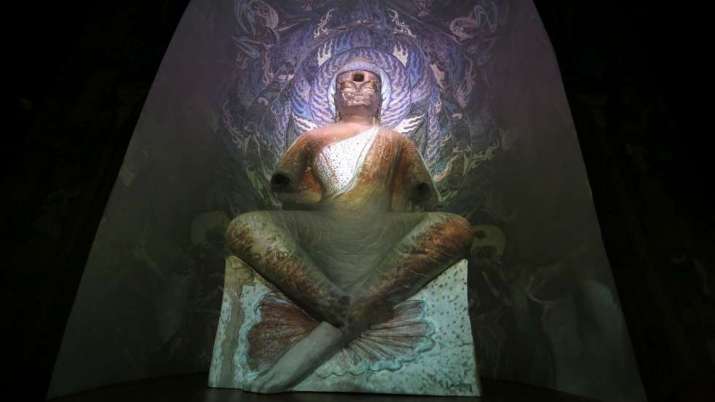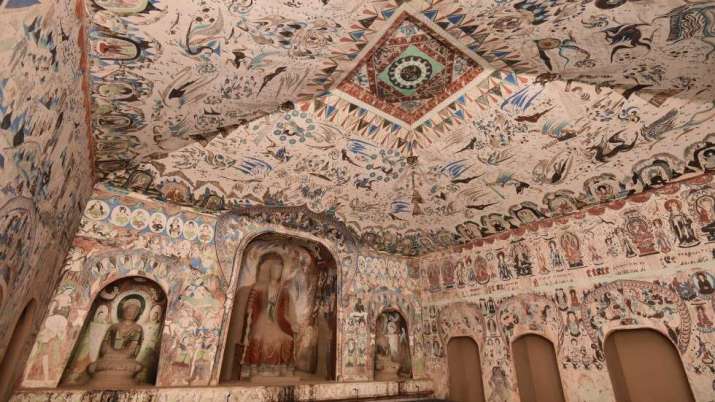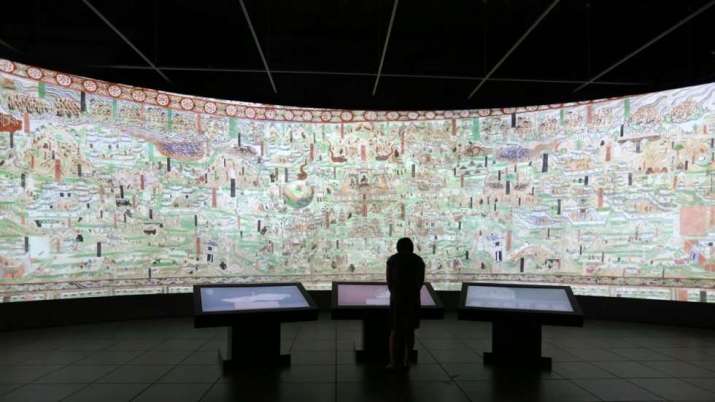
The Hong Kong Heritage Museum has opened an exhibition of 3D digital reproductions of the ancient Buddhist Mogao Caves of Dunhuang in northwest China. The exhibition, titled “Digital Dunhuang – Tales of Heaven and Earth,” opened to the public on 11 July and will continue until 22 October.
Dunhuang was a religious and cultural crossroads on the Silk Road, an ancient network of trade routes that connected the East and the West, in present-day Gansu Province. It is best known for the nearby Mogao Caves. The exhibition is presented by the Leisure and Cultural Services Department of Hong Kong and Dunhuang Academy, and is sponsored by the Hong Kong Jockey Club Charities Trust and the non-profit organization Friends of Dunhuang.
The digital reproductions on display in Hong Kong are the result of a remarkable conservation project launched in 1990s. The Dunhuang Academy partnered with a number of scientific research institutions to digitally preserve art from the Mogao Caves, which are under threat from tourism and environmental factors. The numerous murals and sculptures in the caves have been scanned with a 3D scanner which took an average of 40,000 images per 300 square meters in order to produce the high quality reproductions presented at the exhibition.

“The digitisation project is a challenging task because of the cave environment, such as poor lighting and uneven surface of the walls,” said Fion Lin Hoi-yan, assistant curator at the Hong Kong Heritage Museum. “After taking the scans of the images, they check the colour and clarity . . . and then they do post-production, stitching the images [together] on the computer. It is a difficult job to ensure the high quality of the images, which must have a 50 per cent overlap with other images to ensure the best quality.” (South China Morning Post)
Explaining the extent of the project, Lin added: “The project started in the 1990s and represents a monumental effort in cultural preservation by collaborating with domestic and foreign scientific research institutions. Studies have shown that in Mogao Cave alone, both temperature and carbon dioxide concentration level can be raised with 15 tourists inside for 10 minutes. Coupled with the desert climate, the murals are going to eventually fade. So a balance has to be struck between sharing the relics and preserving them.” (South China Morning Post)
One of the caves on display is No. 285, one of the earliest (dating to the Western Wei dynasty (535–57 CE) and best preserved caves that is not open to the public. The murals of the cave are painted in energetic brushstrokes in a pallet that consists of blues, greens, and terracotta. The ceilings of the cave are adorned with flying female spirits in flowing robes, with a surprise appearance by three non-Buddhist deities: elephant-headed Ganesha, and Shiva, principle deities in Hinduism, and the Greek moon goddess Selene.

According to Lee Chack-fan, director of the Jao Tsung-I Petite Ecole at the University of Hong Kong, and president of the non-profit group Friends of Dunhuang, the Indian and Greek imagery in the caves illustrates the importance of Dunhuang as a crossroads of East and West. “For more than a millennium, trade between East and West was largely conducted on the Silk Road on land; it’s not just one road—it’s a network of trade routes between East and West. There’s China at the eastern end, and west of China there’s India, the Roman empire, Mediterranean region, and then Central Asia and Xinjiang,” Lee explained. (South China Morning Post)
“Dunhuang was basically the gateway to ancient China. All this would be reflected in the murals in the caves at Dunhuang. In the early years, you see the Indian influence in the murals, as well as Persian and Greco Roman,” Lee said, adding: “With time the murals become more and more in tune with Chinese artistic style. Not just the murals, but Buddhist statues, too.” (South China Morning Post)
In addition to cave No. 285, the exhibition features more than 100 installations, including virtual reproductions of caves No. 45 and No. 254, a digitized mural of Wutai Mountain in cave No. 61, and many other artifacts, interactive multimedia installations, animations, and other audio-visual programs.
See more
How 3D imagery of Dunhuang Silk Road cave paintings helps preserve Unesco site and shows murals in new light (South China Morning Post)
Immerse in the otherworldly art of Dunhuang (South China Morning Post)
“Digital Dunhuang – Tales of Heaven and Earth” exhibition unveiled (The Government of the Hong Kong Special Administrative Region)














